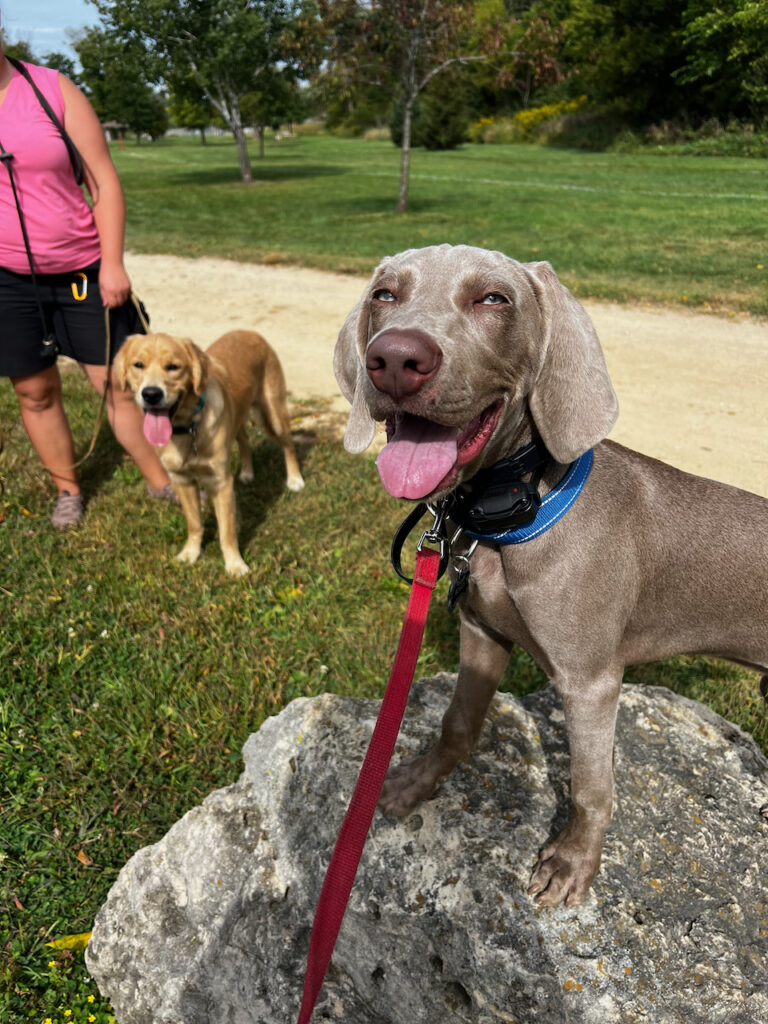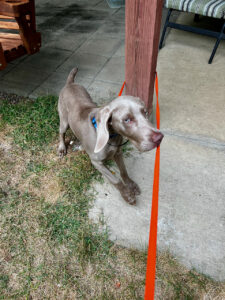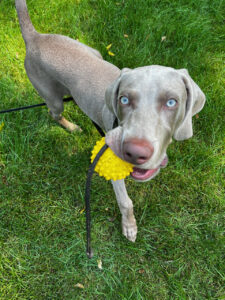How do you feel when you see your puppy dealing with stress? Do you immediately step in and “rescue” them from anything uncomfortable? What if I told you that stress and dogs can go together to create beneficial experiences?
When a young Weimaraner recently joined my board-and-train program, I informed his owner that his life was about to change. He’d be living under some new rules, including crate training at night, learning to walk politely on a leash, and participating in exercises designed to improve his body awareness. While all of this would introduce him to some stress, it was precisely what he needed to build his confidence and problem-solving abilities.
On his very first day, we encountered a simple situation that became a valuable learning moment. While walking, he got stuck on the opposite side of a pole from where I stood. Instead of rushing to fix the problem, I did nothing. I didn’t tug the leash, call his name, or offer an array of soothing words. I just stood there and waited. It took him about 90 seconds of wiggling, whining, and thinking—but he figured it out himself. After sorting it out, he joyfully went on his way, romping in the grass.
The next time he got caught up, he figured it out in half the time. After the third time it happened, it never occurred again! He had learned to stick closer to me as we approached obstacles on our walks.
Controlled stress is vital to grow puppies into healthy dogs.
A pup that grows up shielded from all minor stressors can become anxious and overly dependent on its owner. This is not a healthy mindset for a dog to live with.
On the other hand, allowing puppies to experience minor stressors teaches them resilience. They learn that they can navigate and overcome challenges on their own. Whether it’s solving a problem like untangling themselves from a leash or adjusting to a new environment, these experiences help a dog develop emotional strength.
I used a similar strategy when I raised my children. As they grew, they had the training wheels removed from their bicycles. A bit of encouragement got them to jump off the high dive and participate in activities that challenged their sense of security, like ropes courses and rock climbing.
I didn’t do those things because I hoped my kids would grow up to ride the Tour de France, become Olympic divers, or do extreme sports.
The purpose was to build character—physically and emotionally. Every parent wants their kids to grow up to be successful adults, and that requires the development of coping skills. We know they will encounter stress, and we know we can’t be there to bail them out forever. The only way to prepare them is to prepare them.
Dogs are the same. They need to learn to deal with things that cause stress or things they don’t immediately like. Just because your dog “doesn’t like” being in a crate or being brushed doesn’t mean you should give up trying.
It means you must put more effort into teaching the pup to tolerate it. 💪
How can you expose your puppy to healthy stress?
Intentionally introducing your pup to some stress is beneficial for its development. Plus, these activities can be fun and strengthen the relationship!
Here are some simple ways to expose your dog to healthy stress:
- Proprioceptive Exercises: Activities like walking on different surfaces help puppies encounter new sensations that challenge their comfort zones. Walk your pup on grass, gravel, sand, and uneven terrain. Set up an obstacle course in your backyard. Use items like a plastic tarp, a box to step in and out of, and a ladder on the ground. Then, encourage the pup to explore by going over, under, and across these unique things.
- Problem-Solving Games: Mental challenges can include hiding treats under cups or placing them inside toys that require effort to retrieve. These puzzles teach patience and build problem-solving skills. One of my favorite everyday experiences involves NOT retrieving the ball every time it rolls under the chair or sofa. Rather than doing all the work, I encourage my puppies to try on their own. I lift the furniture just enough that they can crawl under and grab it themselves.
- Social Outings: Take your puppy to new places like public green spaces, dog-friendly stores, or outdoor cafes. Experiencing different sights, sounds, and people builds confidence. Don’t pay attention to hesitation by petting or soothing the pup. Instead, get them busy playing with a toy or encourage them to sniff and investigate the “scary thing” by YOU investigating it first. If you lead by example, your pup will follow. The more exposure they can have early, the more you increase the likelihood they can remain calm in novel situations later in life.
- Crate Training: Crate training often comes with initial protests, but learning to settle in a crate is invaluable for your dog’s independence and your peace of mind.

Raising a puppy is not about shielding them from every discomfort. It’s about teaching them how to navigate and overcome challenges independently. Expose your pup to manageable amounts of stress and guide them through problems.
If you need help, this puppy training course will guide you through various exercises to set your pup up for a lifetime of confidence and emotional stability!
—


